Most people need some light when they tie flies. Some people more than others. This article is about lamps to use over your vise and table when tying.
Personally I'm blessed with an eyesight that allows me to tie flies in almost any light. I usually don't use a special lamp, but do with normal daylight or available room light.
But I'm well aware that most people need extra light when tying, and this article goes through many of the options and gives some recommendations on choosing and setting up a fly tying light.
What you want
What most people want from a fly tying lamp is simply a sufficient amount of good, bright light. Duh! Not exactly rocket science, is it? No, not exactly, but still there are some things to consider when you select your lamp.
Some people like a small, intense spot of light right on their fly. Some people like a more diffuse light with no shadows, but still close. Some people like a more distant light source that lights up the fly and the table and some people want more than one lamp, so that all angles and spots can be covered. You may want a fixed setup, but flexibility and ability to move the light around might also be a desire.
Depending on your tying location you may want a compact lamp. If you need to set up and break down often, like when tying on a dining or kitchen table, you may want something no too bulky, and preferably something that packs down small.
Not exactly rocket science, is it?
If you use a tying bench of some kind, maybe your light can be attached to that, not demanding breaking it down every time you leave the vise.
In a permanent fly tying cave, you can do with a larger lamp, which won't have to be packed down every time you stop tying. You can even have something that hangs above the table in stead of standing on it or clamping to it.
Fly, table, room
Before acquiring a lamp, you need to consider what you want lit. I see basically three scenarios:
- lighting the fly
- lighting the fly and the tying area
- lighting the fly, tying area, the full table and maybe even part of the room
The lights I mention here will cover the first two cases, but not the last. For that you need to think in a much larger scale and have something ceiling mounted, which gives a lot of light. Like a lot.
In the first two cases the need depends on your temper and your eyesight.
You can have a small lamp that just gives you extra light on the fly itself, but not much on the table. That will include most stem mounted lamps plus some clamp or foot mounted lamps with longer reach, but still a small lamp head.
|
|
|
|
|
|
|
|
|
|
|
|
You can go a bit bigger and get something that lights up your tying area and your fly. Most desktop, work and reading lamps will do that, but at the cost of being larger.
For permanent setups like a tying table, a larger lamp that does the latter may be your thing, but for the traveling tyer or the one who sets up and breaks down often, a small light on the fly may be the solution.
You can of course also simply use more lamps. That both increases the amount of light and the options to get it spread out over your work area.
Lamp types
There are a lot of lamp types, which are suitable for fly tying, and these are just some of them:
Desktop work lamps, the classic architect lamp type, which gives a nice, even, well diffused light using a normal bulb. These days they use LED bulbs, but most these lamps were designed in a time where the classic screw-in bulb was what you used. They are flexible but a bit clumsy and fill quite a bit, and are most suitable for a permanent setup.
Halogen desktop lamps, which are typically much more compact, but need a converter and will become very hot. These are slowly disappearing and being replaced by LED lamps.
The fluorescent tube desktop lamp doesn't use a bulb or LEDs, but a tube more like what we see in ceiling lights in factories or warehouses. These lamps are large and mostly made in the architect lamp design, but do give a very bright and well diffused light. These are also large and best suited for permanent setups.
Single LED lamps are the most common type of desktop lamp today. They are compact, energy efficient, cold when turned on and long lasting. They come in a wealth of shapes, mostly with small lamp heads and typically with a converter.
Multi LED lamps also use LED's as a light source, but typically have several, like 6-10 LEDs or even more in the same lamp. Each LED is may be slightly less bright, but together they give a diffused and clear light. Some of these lamps have small and round lamp heads, some have rectangular heads.
LED panels are much larger than multi-LED lights. They hold hundreds of LEDs and give a very soft and potentially very bright light. They are made for photo and video purposes, but can be used as a work lamp for the really light hungry tyer.
Stand, clamp, mount
The lamp can be mounted in all kinds of ways. For fly tying lamps, the most common is a lamp standing on a heavy foot or attached to a holder clamped to the table or bench. But some lamps are mounted directly to the vise, utilizing an attachment that sits on the stem or the pedestal.
In permanent setups you can mount lamps on walls and ceilings, but most people will still use lamps that can be moved, like classic architect lamps.
The configuration depends of your needs to move your vise around or how often you break down your tying station and set it up again. The more permanent your tying location, the less your concerns in this respect.
Power supply
The lamp can draw its power directly from the outlet, which will be the case with most larger desktop lamps. But LED and halogen lamps typically run on lower voltages, oftentimes 12 volts but some down to 5 volts. These will require a converter or at least a power source. 12 volts usually means you need a special converter for the purpose. For many LED lamps the converter simply comes with the lamp, and some have it built into the base.
5 volt lamps essentially run on the voltage also used in USB, and can be powered by many of the more powerful phone chargers provided that the cable connection is a USB plug. USB-lamps can also run on energy from a power bank, the type that's known from phones. This will make you independent from outlets and extension cords.
A few vise lamps are battery powered, basically being LED flashlights mounted on a goose neck. They can be good in makeshift setups or for traveling, but for a more permanent solution, most people will prefer a lamp that can be plugged in.
Color temperature
Contrary to what you might think, the color of the light - referred to as the color temperature and measured in Kelvin - isn't a very important aspect of the light as long as it's within a normal lamp specter, which the far majority of lamps are. There are essentially two dominant color temperatures: classic incandescent bulbs and daylight. Classic bulbs give off a fairly warm and yellowish light while daylight is colder and more blueish. Within this range your brain is easily able to adjust and see the fly and material colors as they are. Since most modern LED lights can be had in almost any color you want, the problem isn't the same as it was when the choice was bulbs or fluorescent tubes. Even back then the problem was manageable. People have after all been tying under these lamps for decades and done pretty well. Further back people tied in candlelight and managed.
If you often take pictures of your flies under the tying lamp, you may want to get a lamp with a neutral light, and if you want to have more lamps, you should also make sure that they are the same color temperature.
Magnifiers
For those who need some help to see what's going on on small flies, there may be a solution in choosing a lamp with a built-in magnifier. These are quite widely available, commonly in the form of architect style lamps and mostly rather large. Some use a bulb while others use a ring-shaped fluorescent tube. Recently more compact LED-lamps with magnifiers have started appearing, and some compact models with goosnecks are now available at quite reasonable prices in many stores - online and out in the real world.
|
|
|
|
Below are a few of the colossal selection of lamps made for or useful for fly tying. The first ones I own and use or have used, the rest I just found interesting and worth mentioning.
McKenzie Fly Tying Vise Light
A cool aluminum lamp that I bought once in the US. The lamp is old fashioned 12 volt halogen and is both compact and flexible. It's a simple goose neck mounted on a clamp that goes on the vise stem. The lamp sits close to the fly, but far enough away to allow for free movement around the fly. The only disadvantage is that it gets very hot! My old friend Ken once got a burn mark on the forehead from leaning too close to his identical lamp! I have now replaced the halogen G4 bulb with an LED bulb in stead.
If you change a traditional halogen and use an LED, make sure you get one bright enough. A 1 Watt LED may give you 80-100 Lumen and a 2 Watt LED 150-200 Lumen, which should be more than enough for a small light close to the vise. Bulbs using less than 1 Watt are probably just on the weak side for this purpose.
The McKenzie is still available in some flyshops in a couple of different models, and is sold for about 80-90 US$ so it's not a dirt cheap lamp. If you want a lamp to clamp onto the vise stem, consider making your own as described in this article.
IKEA Jansjö
My other fly tying lamps are from IKEA. I bought them to use at a fly photo demo at the Danish Fly Festival, are now retired to the job they were originally meant to do: bed lamps. They are simple LED lamps, bought for 10 dollars each. They are excellent, compact goose neck constructions with a heavy foot and a small lamp head. Tall enough to reach over the vise, flexible enough to be positioned as you want it. Perfect for fly tying.
Jansjö is a whole series, which can come with a base, a clamp and even as a USB lamp, and work very well as they are. But these lamps are also perfect contenders for some DIY, and can be taken apart and mounted on a tool caddy, on the base plate, on a tying bench or basically anywhere you'd please.
The lamps in the series come with a power supply, except for the 5 dollar USB version, which can be fed from a phone charger or even from a computer.
Prices are very convincing, with 10 dollars for the bigger models and 5 dollars for the USB lamp.
Cheap Aldi LED lamp
This lamp is a good representative for two categories of lamps: the multi-LED type and the cheap bedside type. It was given to me by German friends, and is an excellent fly tying lamp that gives plenty of diffused light. It's not elegant, it's not particularly compact and it's not extremely well made, but it certainly does its job well and was inexpensive.
Cheap halogen bed lamp
I bought this halogen lamp many years ago to use as a bed lamp, but also used is for fly tying, not least because it's one unit with a built-in converter, so that no separate converter was needed. It also packs down to a small package, suitable for bringing in a tying kit when not tying at home like on shows or on fishing trips.
It was bought in a super market where I found it in a bin, and was really cheap.
LED panel
The large LED panel is a new addition to my arsenal of lamps. It was bought to set light for fly tying videos, and as such gives a bright, even and very controllable light. It's probably overkill for most tyers, but never the less two of my fishing friends have bought similar lamps after seeing mine.
It contains 100 LEDs that can be dimmed and light temperature can be controlled. It can give off a colossal amount of light and thanks to its size, this light is very well diffused and basically gives no shadows when placed at a normal working distance.
But being what it is, a large panel meant for professional photo work, it's also heavy and requires quite the setup to get in position, making it a little awkward to use for normal tying work.
There are many models available. I bought mine on eBay. It's called Excelvan 680S LED Video Studio Light and set me back about 100 UK£ including postage. The same panel can now be had for about 80 UK£ or about 100 US$, which includes a power supply, a remote control and a light stand. Still not a cheap lamp, but man, the light is nice!
Other lamps
My late friend Ken was very pleased with his lamp from Marc Petitjean, of which he had an older model attached to the table with a clamp. The current Petitjean models sit on the vise stem and can be had with or without a tool holder.
As always Swiss Marc Petitjean knows what to charge, and at 200 and 250 Euros or 220 and about 280 US$ they are about the most expensive lamps of this type you can find on the market. Nice for sure, but also crazy expensive.
Danish Fly Company has a lamp much like the Petitjean, also at a fairly high price, namely 1.100.- DKK or about 150 Euros or 160 US$. This lamp has just come out and isn't widely available yet.
The Giraffe Lighting system was popular and often seen on fly tying show tables and in magazines. They seem to have been discontinued now, and only available as old stock in a few shops. This was also an expensive system with prices in the 180-250 US$ range depending on the configuration. As I said: popular with many tyers, but a little large and industrial for my personal taste. They used to be at http://www.giraffelamps.com/.
Peak, a manufacturer who makes vises and tools, also have a stem mounted lamp called Peak Portable Light. It's a vise post mounted LED lamp with a 20” flexible gooseneck. It's large and bright enough to light up both the fly and the table under it, but also quite bulky. It comes with a small tool bar in the mount for your most commonly used tools, and sells for about 140 US$.
What to buy
Unless you want a lamp to mount on the vise stem, you are generally just as well off with any LED lamp of a suitable power, size and construction. And those can be bought online and in physical stores for 10 US$ or less.
You can also build you own cool, stem mounted lamp.
Hand picked for this article
- Log in to post comments

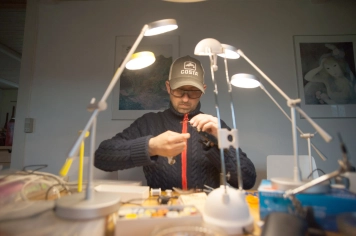
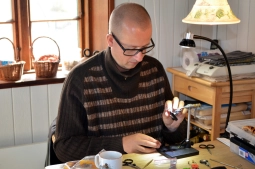
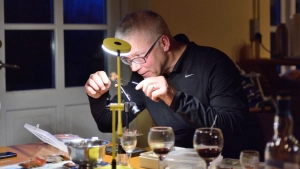
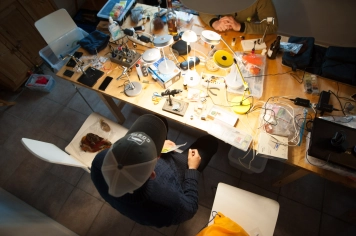

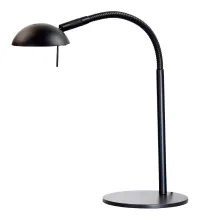

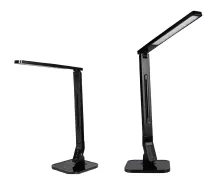
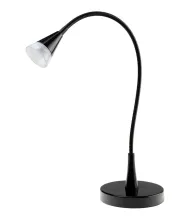


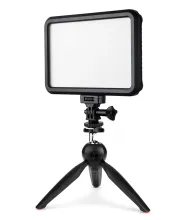

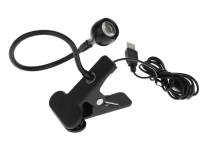


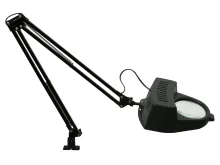
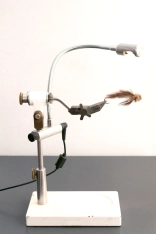
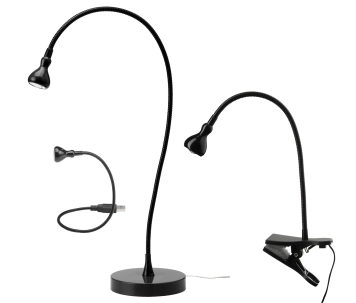
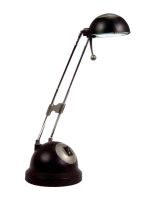


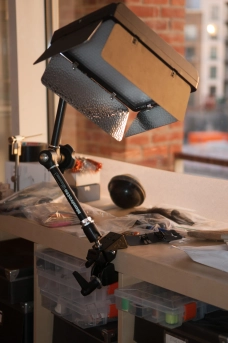
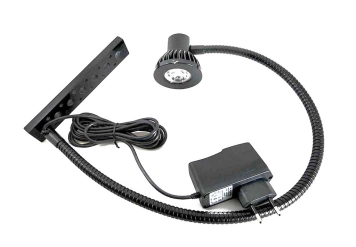


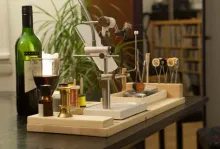
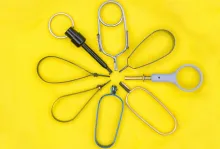
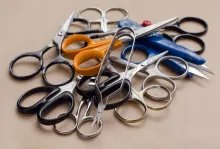
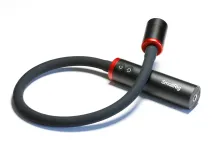
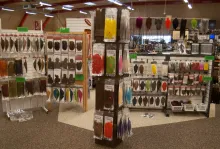
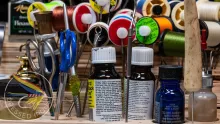


Fly tying lamps
Dear all,
this is a serious advisory. Check it for yourself.
2010 I got diagnosed MD, Macula Degeneration. Iwas diagnosed to becoming blind.
I was a Computer Grafic and 3D Designer since 1987, first Flatscreens and 12 hours work in front of LED_Screens.
RGB = Red, Green, Blue LED'S in a matrix.
White and Blue LED's emerce a high frequent light, it's laserlight.
The blue light destrois the Retina - Macula Lutea Part of the Retina.
I'm not getting blind, I lost my business, but reversed my MD. Getting retiered soon, anyway.
That's what I did:
8.000 - 10.000 I.U. Vitamin D3 + Vitamin K2
Lots of raw green leaf vegies.
Most important:
Orange Glasses (High quality Sunglasses are okay), Blue absorbingly 98%, when working at the computer screen.
I where them all day long.
Giving up my business, I go fishing, tie fys and furle leaders.
My MD got better about 50%, I'm not getting blind, I'm improving. Ask my Clinc.
I use normal Lamps and Halogen - no LED'S. Best for Flytying - Sunny Days ore Daylight.
At darkness or night, don't tie. Sleep, than eat, than tie, than go fishing.
Profe my words.
Regards and all the best,
Winiefred
How did you table mount the
How did you table mount the LED panel?
It seems like the best option in every way in my opinion.
Bring out the big gear
Jon-Anders,
The LED panel is pretty awesome, but also a beast. I use a Manfrotto lamp swivel head, a Friction Arm and a Super Clamp to hold it. It's a large and heavy thing and needs some serious support. I will see if I can dig out a picture of my setup and add it to the article.
Martin
LED Panel - DIY flex arm
Recently saw this video on Youtube illustrating how to make a flex arm lamp using a LED panel: it's surprisingly inexpensive. https://youtu.be/JL3uZ88vA_0
I've filed this on away just in case; my 30 year old Giraffe lamp with an LED bulb is still a terrific light source and no where near the end of its useful life.